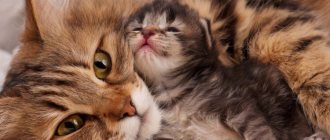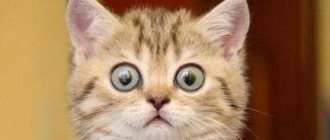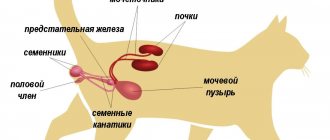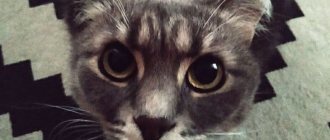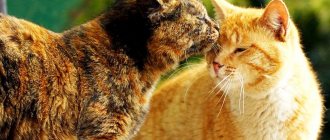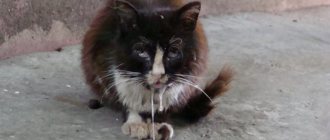What are cat whiskers?
A cat's whiskers, also known as whiskers, are tactile hairs that help cats sense their surroundings. They use them to sense and detect objects nearby, and to detect changes in the surrounding air flow that can alert them to nearby predators. They serve as an important sensory tool for cats.
© shutterstock
What is the correct name for a mustache and why?
The scientific name of the mustache is vibrissae, translated from Latin, meaning “to wriggle”, “to oscillate”. If you look closely at the pet, you can see that they are really shaking. The cat's whisker follicles contain many nerve endings that capture air currents from objects and send information about the outside world to the animal's brain.
Interesting! Scientists have been able to establish that the mustaches of the ancestors of modern cats appeared earlier than the coat.
Why do cats have whiskers?
A cat's whiskers act as an important sensory tool for cats, which they use for a variety of purposes.
All cats have excellent night vision, but they have difficulty seeing nearby objects. Their whiskers serve as a tool for detecting nearby objects that are too close to be seen well. Second, a cat's whiskers are so sensitive that they can detect small changes in air flow that may indicate nearby animals or predators.
The whisker has several other functions, such as triggering reflexes, a navigation tool in the dark, or measuring the width of a narrow space or entrance. They also help them climb and determine the distance to their prey. You see, whiskers are truly a cat's sixth sense.
Is it possible to trim a cat's whiskers?
Trimming whiskers is strictly contraindicated. Without whiskers, it will be difficult for a cat to navigate in space. She will bump into various objects and fall while jumping. Also, without whiskers, a cat will not be able to move in the dark, and will use its paws to determine the temperature of food.
An animal with damaged whiskers should not be allowed outside. Left without a mustache, the cat will become fearful, insecure and defenseless.
On a note. In rare cases, veterinarians shave cats' whiskers to enhance the therapeutic effect. This is done to treat fungal diseases and in cases where the whiskers have grown so long that they cause discomfort to the animals.
Why do cats lose their whiskers?
Just like regular hair, a cat's whiskers need to be updated from time to time. It is the body's way of healing itself. Lost mustaches will automatically grow back within a few weeks. If your cat is losing too much fur or whiskers, it could be a sign of stress. In this case, it is better to consult a veterinarian.
Do whiskers help cats see at night?
Cats have excellent night vision, but a cat's whiskers also play a vital role in finding their way in the dark. Because of their sensitivity, whiskers can detect subtle air currents in a room and allow cats to detect obstacles from a distance, even in complete darkness.
A man put up a cat's whiskers for sale, and a buyer with specific requests became interested in them.
Pikabu user with the nickname alexsush2 shared a rather funny and slightly surreal dialogue. He has a cat and a female cat at home, and these animals sometimes lose their whiskers. For some reason, the user’s wife collects this mustache and puts it in a bag. Having discovered that there was quite a decent amount of mustaches, the man decided to have some fun and put them up for sale. But do you know what's most surprising? The buyer is interested in them!
A man put up the lost whiskers of his cats for sale, and a buyer became interested in them.
This is what the product looks like
And here it is - its manufacturers
It would seem that everything in the situation is strange: collecting mustaches, selling them, and making a guitar with mustache strings, and always with black strings. But no, Pikabu users are seasoned people, nothing will surprise them. It turned out that advertisements for the sale of mustaches are not a new idea, and many people collect them, and even find use in everyday life!
It turned out that many users also collect their cats’ whiskers. This, for example, with a fold ear for 7 years
Look, there are still black ones!
“I was thinking about drawing a picture of my cat and gluing on real whiskers, but I don’t know how to draw.”
"My God! I not only collect mustaches, like many here, but I also put them in the same Ikea box!”
"The game 'guess what's in the box.' Almost everyone thinks it’s either jewelry or drugs.”
There was a whole bouquet gathered on the shelf next to the monitor.
“We have black ones in stock. Price is negotiable (the decision is up to the cat). Not used, not broken, not painted.”
“I’m implanting lost cat whiskers into a lizard.”
“For tank models in 72nd scale, cat whiskers go well with antennas.”
“I also saved up and then used them for a custom Blacksad. True, now I’m planning to shorten them a little.”
Keep your head up, cat owners! This product disappears!
Did you know that we have Instagram and Telegram?
Subscribe if you are a connoisseur of beautiful photos and interesting stories!
Source of the article: https://bigpicture.ru/muzhchina-vystavil-na-prodazhu-koshachi-usy-i-imi-zainteresovalsya-pokupatel-so-specifichnymi-zaprosami/
Whiskers help cats determine if they're passing
Have you ever seen how a cat can fit into the narrowest of spaces? How do they know in advance whether they will fit inside or not? It turns out their mustaches act like measuring tapes.
Before the cat squeezes into the small, narrow space, they carefully poke their head into the hole. It may seem like they are trying to feel something when they do this because you will notice their nose and upper lips moving as they do this.
They actually measure the width of the hole by moving their whiskers and touching the edges. The ends of the whiskers on each side are positioned the width of your cat's body. They know that if their whiskers come through, so does the rest of their body.
© shutterstock
Mustache problems and their causes
If individual vibrissae fall out and new ones grow in this place, then this is a natural renewal process that should not cause alarm to the owner.
However, if the mustache begins to break or fall out in large quantities, then it is necessary to understand the reasons for what is happening and eliminate them.
Problems may be associated with improper living conditions for the animal, and then they can be solved quite simply.
- In autumn and winter, thanks to heating devices, the air in the house may be too dry, which has a bad effect on the condition of the mustache. The solution is simple - ventilate more often or use humidifiers. This will benefit people too.
- Too frequent bathing, especially with fragrant shampoos, which can cause allergies and irritation in the animal. You should bathe your cat only when necessary and use high-quality detergents.
- Hormonal imbalance in the cat's body. They can be caused by stress, adolescence, pregnancy and childbirth and other reasons. Here you will need to consult a veterinarian.
- A cat can simply singe its whiskers, near the fireplace or on the gas stove. Not all animals are afraid of fire. It is necessary to follow it and determine whether the animal is too close to the flame.
- The cat doesn't drink enough water. You need to make sure that your pet always has access to clean water.
If a cat drinks little, this can negatively affect the condition of its whiskers.
Poor nutrition in a cat can also lead to problems with the whiskers, and, most likely, it will manifest itself in other health problems. From a lack of essential nutrients, the vibrissae become fragile, brittle, thin, and lose their elasticity. This condition is called vitamin deficiency.
Lack of vitamins often leads to brittleness and thinning of the whiskers
When feeding natural food, the diet must be balanced taking into account the needs and age of the animal; it is advisable to contact an appropriate specialist (nutritionist or veterinarian) for this purpose. The cat should receive only fresh and high-quality products, and natural ones, without surrogates, chemical additives and substitutes (of which, for example, there are so many in sausage). You should not give the animal fried, smoked, salty, sweet food, or feed it stale scraps from the human table. Be sure to add vitamins and minerals to your daily diet.
When purchasing vitamin complexes, it is recommended to pay attention to those that contain taurine and biotin - the most important components of a cat’s proper metabolism. The essential minerals are calcium, magnesium, phosphorus and potassium.
Specific vitamin preparations and their dosage regimen to improve the condition of the whiskers should be recommended by a veterinarian
When feeding industrial food, you need to choose high-quality, expensive brands from well-known manufacturers. Economy class food is made from beans, which are not a natural food for cats and are completely useless for them. In addition, there are many artificial additives and the composition is not balanced in vitamins and minerals.
Brittleness and loss of whiskers may be the result of an animal’s allergic reaction to some food component. Most often, cats are allergic to milk and fish, as well as to the chemical components of the products. The disease is accompanied by itching, hair loss, skin rashes, and eye problems.
In addition to allergies, mustache loss can be caused by other, more serious diseases.
- Hypothyroidism or hyperthyroidism are diseases of the thyroid gland associated with insufficient or excessive activity of this organ. The first signs of a hormonal imbalance in the body will be thinning and loss of hair and whiskers, as well as a sharp change in the pet’s weight.
- Diabetes mellitus in a cat also leads to loss of whiskers and fur.
- Mycoses are fungal diseases, as well as dermatitis, bacterial infections and other skin diseases, including lichen, accompanied by severe itching, peeling, hair and whisker loss.
- Parasites such as worms, fleas, ticks, and lice eaters reduce the animal’s overall immunity and can cause whiskers to fall out. A sharp lightening of the whiskers at a young age almost always indicates that the cat has become infected with worms.
Whiskers falling out may indicate a cat is infected with parasites.
What do whiskers say about your cat's mood?
If you observe your cat closely, you may have noticed that she can move her whiskers, unlike other hairs on her body. This is because the whiskers are deeply rooted in the skin and connected to the muscles.
A cat's whiskers can give you an idea of your cat's emotions at a certain moment. If their whiskers are pushed forward, it indicates that they are curious. If they are being held harshly in the face, it usually means they feel threatened. A relaxed mustache is a sign of happiness and contentment.
The structure and location of the whiskers in cats
Whiskers have been present on the faces of both male and female individuals since birth. The presence of this important organ does not depend on breed or genetics. But the difference in the length and thickness of the whiskers is associated with individual characteristics: breed, sex of the individual, conditions of detention. Knowing their structure and location will help you find out why a cat needs a mustache.
What are they made of?
The long hairs on the cat's face have an interesting structure. Each whisker is connected to a specific part of the brain and is responsible for the functioning of a specific system of the animal. This is why a cat needs whiskers: from the signals from the whiskers in the pet’s head, a complete picture of what is happening is formed. The hairs themselves grow up to 5-7 cm and consist of:
- nerve endings;
- skin glands and epidermis (the part invisible to the eye);
- the vibrissa itself.
The thickness of the hair is explained by the large number of nerve endings and sometimes depends on gender. Because of these endings, a tubercle appears at the very base of the hair.
Luxurious mustaches are found in individuals whose owners take care of a balanced diet rich in vitamins and microelements. On average, the length of the hairs in both directions is equal to the width of the mustachioed friend’s body.
Whiskers are not only on the face!
It is a mistake to assume that cats' whiskers are located only on their faces. Long, thickened hairs can be seen on different parts of the fluffy's body. They differ in quality from the whiskers on the muzzle. Vibrissae in cats grow:
- above the eyes;
- in the nose area;
- on the chin;
- in areas around the lip pads.
In addition to the listed places, long hairs are located on the front legs, but they are practically invisible there. A curious owner of a mustachioed pet can carefully examine the paw slightly above the area of the dewclaw (pad without a claw). This is where thickened hair grows. Why a cat needs whiskers on these parts of the body can be understood by observing the habits of a furry friend.
Does a mustache grow?
Whiskers that are lost, trimmed, or otherwise damaged will grow back in their original location. A completely lost mustache usually grows back within a few weeks. If your cat has had severe hair follicle trauma, the lost whiskers may never grow back, but this is quite rare.
Whiskers do not grow slower or faster depending on the cat's age, but at approximately the same rate throughout the cat's life.
The length of the whiskers is determined genetically, and once they reach a certain length, they will stop growing and will remain approximately the same length throughout your cat's life. The mustache does not grow indefinitely, so it does not need to be trimmed or trimmed.
Who is buying this? Cat whiskers and other junk sold online
Some even manage to make money from garbage - they put it up for sale and...
Text: Irina Vasilyeva · February 5, 2021
During quarantine, like many others, I started decluttering my apartment. My hands finally reached the mezzanine in the corridor, where I look at most once a year. A friend went through a sideboard littered with old dishes, a colleague gutted the boxes on the loggia. All unnecessary rubbish was mercilessly sent to the trash heap.
I learned too late that you can make money from trash too. Sometimes you come across advertisements on the Internet and wonder: does anyone really need this?!
Old frying pans and pots
You never know what circumstances there are! I remember about 25 years ago, my friend and I were driving through Moscow to the Grushinsky festival. We had to spend more than a day in the capital, there was no money for a hotel, and therefore it was decided to pitch a tent in the nearest Moscow region. At the station square it dawned on us: there was no pot. “Now we’ll buy an inexpensive saucepan somewhere nearby,” the friend reassured. But “nearby” it turned out to be a not at all cheap Moscow department store, where the aluminum saucepan was bought for a lot of money. It was a pity - not the right word, but what to do?
Now it’s easy to buy a saucepan for camping on a free classifieds site - you save money and don’t mind throwing it away later. There are dozens of proposals. Mikhail from Yekaterinburg is the owner of a whole collection of such “aluminum scrap”. There are miniature ones, as well as 8 liters for a respectable company. Price - from 50 to 200 rubles per piece.
Source of the article: https://www.wday.ru/dom-eda/interer/kto-eto-pokupaet-usy-kota-i-drugoi-khlam-kotoryi-prodayut-v-seti/
A battered Soviet briefcase
Well, who needs an old, battered travel bag with the handle almost torn off? At best, he will face the fate of a “country chest” in which the same rubbish is stored. But collectors will not agree with this message. There are more than enough advertisements for the sale of portfolios that remember Brezhnev, and maybe even Khrushchev. In Kamensk-Uralsk, for example, they offer it for only 1000 rubles. purchase the portfolio of a certain assistant professor from the 70s. “The condition is good, clean, without scuffs, perfect for photo shoots,” the owner describes his treasure.
There are economy options for 350 rubles. For this amount, a resident of Yaroslavl is ready to tear from her heart a large travel bag with paint stains, rust on the metal and the lining torn off in places.
But a Muscovite sells a briefcase made of Soviet leatherette for 4,000 rubles. “The housing and all accessories are in excellent perfect condition. The inside is uncritically dusty. The locks work, the keys are there,” the ad says.


